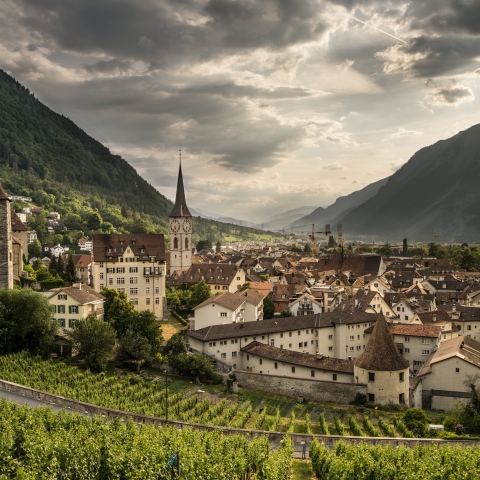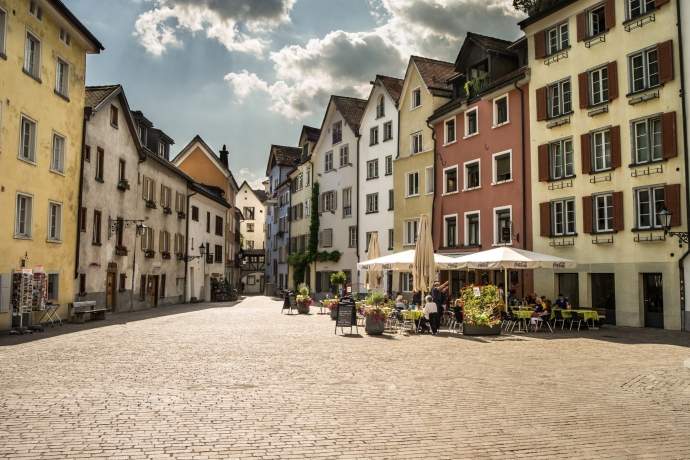History of Chur

History of Chur
More than 2000 years ago, conquest by the imperial stepsons Drusus and Tiberius marked the beginning of the Roman past of present-day Chur. However, Chur was settled far earlier: finds date back to around 11,000 BC. In prehistoric and early history, the left (Welschdörfli) and right (Sennhof/Karlihof) bank of the Plessur were settled, in the late Roman period, a fort was built on the farmland.
Asinio was named as Bishop of Chur for the first time in 451 AD, however, the beginnings of the diocese likely date back to the 4th century. At the end of the first millennium, the bishop took on an increasingly important position in secular matters. He benefited from the favour of the German emperors, who gave him important privileges, such as making him in charge of customs for Chur in 952. From 1299, the bishop presided had jurisdiction over Chur and a number of surrounding villages. As sovereign, the bishop also had the right to fill posts on the city council and various city offices. As the Middle Ages came to an end, the bishop’s worldly power began to decline. The city had had a fraught relationship with the ‘Court’ for a long time. the predominantly mercantile citizens tried to win city rights and income completely independent. The episcopal castle was even sacked twice. After a devastating fire in 1464, which razed large parts of the city, the citizens sent a delegation to the imperial court of Frederick III, with the court not only awarding them a few ancient rights, but also giving them almost total liberation from episcopal rule.
The new town constitution could then be written, fundamentally based on the newly founded five guilds (winemakers, shoemakers, tailors, smiths and craftsmen). Only citizens of Chur could join a guild; non-citizens were excluded, along with as serfs, illegitimate children and women. The guild constitution regulated even the finest details of organisations and activities. There were regulations on working hours, apprenticeships and numbers of workers per company, acceptance of guild new masters and product quality. Even agriculture, which played an important role in Chur well into modern times, was governed by the guilds. For example, guilds had rules for shepherds keeping livestock in the city. The new guild constitution transferred political power from the bishop to craftsmen; a political career in Chur was only possible as a guild member. Therefore, nobles and patricians also joined the guilds.
The remaining influence of the bishop on Chur was further diminished by the Reformation. Because Chur embraced the new tradition, Protestantism became indispensable for a political career, as well as for civil rights and guild membership.

Chur was repeatedly beset by large fires, not only 1464, but also until the 19th century Chur, leading to whole neighbourhoods being razed in 1574, 1576 and 1674. In 1811, the cathedral houses were damaged by fire, along with the courtyard, tower and roof of the cathedral. During the chaos in the Grisons in connection with with the Thirty Years War, the people of Chur had to endure garrisons of foreign troops - first Austro-Hispanic, then French. The city was also heavily burdened with war debt. Just over 160 years after this turmoil, Chur was once again occupied by troops belonging to foreign powers. During the French Revolution and the Napoleonic wars, the Grisons were part of the battlefield during 1798/1799 and, depending on the war the tide of war turned, the city fell into either French or Austrian hands.
Although the guilds in Chur survived the demise of the old regime and were revived, they increasingly proved to be an obstacle. Political participation being available to only the few, along with lack of freedom of trade met increasing criticism from disadvantaged residents. Only in 1840 were the guilds abolished and a new, liberal city constitution was introduced.
The Grisons have been one of the cantons belonging to the Swiss Confederation since 1803, with Chur becoming the capital after initially competing with Ilanz and Davos. The city has grown unstoppably in the 20th century, especially after the Second World War and currently has 15 times as many inhabitants as it did 200 years ago. This small guild town, moulded by agriculture and transit, has transformed itself into a modern administrative centre in which a large number of not only municipal but also cantonal administrative branches and cultural institutions have established their headquarters, owing to its importance status as an administrative hub.



Show all 6 images
«Chur in brief»
- Capital city of the canton of the Grisons (Graubünden)
- 40'000 citizen
- 554 m to 2'805 m (city area)
- 1'170 m to 2'174 m (area of local mountain Brambrüesch and Dreibündenstein, accessible by cableway from the city)
- 5'000 years of settlement history (Switzerland's oldest city)
- Hub to world-famous health resorts such as Arosa, Davos, Lenzerheide, Flims/Laax and sights such as the Rhine Gorge between Ilanz and Reichenau, the Heidi Village in Maienfeld or the Viamala Gorge in Thusis.

